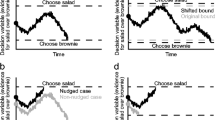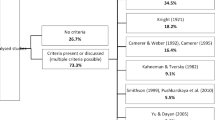Abstract
This article presents an introduction to and analysis of an emerging area of research, namely decision neuroscience, whose goal is to integrate research in neuroscience and behavioral decision making. The article includes an exposition of (1) how the exponential accumulation of knowledge in neuroscience can potentially enrich research on decision making, (2) the range of techniques in neuroscience that can be used to shed light on various decision making phenomena, (3) examples of potential research in this emerging area, and (4) some of the challenges readers need to be cognizant of while venturing into this new area of research.
Similar content being viewed by others
References
Bechara, Antoine, et al. (1997). “Deciding Advantageously Before Knowing the Advantageous Strategy,” Science 275, 1293–1295.
Bechara, Antoine, et al. (2005). “The Iowa Gambling Task and the Somatic Marker Hypothesis: Some Questions and Answers,” Trends in Cognitive Sciences 9(4), 159–162.
Cacioppo, John, Stephen L. Crites, and Wendi L. Gardner. (1996). “Attitudes to the Right: Evaluative Processing is Associated with Lateralized Late Positive Event-related Brain Potentials,” Journal of Personality and Social Psychology 22(12), 1205–1219
Cacioppo, John T., Louis G. Tassinary, and Gary G. Berntson. (2000). Handbook of Psychophysiology. New York, NY: Cambridge University Press.
Camerer, Colin, George Loewenstein, and Drazen Prelec. (2005). “Neuroeconomics: How Neuroscience can Inform Economics,” Journal of Economic Perspectives 43, 9–64.
Damasio, Antonio R. (1994). Descartes' Error: Emotion, Reason, and the Human Brain. New York: Grosset/ Putnam.
Dhar, Ravi and Itamar Simonson. (2003). “The Effect of Forced Choice on Choice,” Journal of Marketing Research 40(2), 146–160.
Greene, Joshua D. et al. (2001). “An fMRI Investigation of Emotional Engagement in Moral Judgment,” Science 293, 2105–2108.
Hasselmo, Michael E., Edmund T. Rolls, and Gordon C. Baylis. (1989). “The Role of Expression and Identity in the Face-Selective Responses of Neurons in the Temporal Visual Cortex of the Monkey,” Behavioural Brain Research 32(3), 203–218.
Hastie, Reid and Robyn M. Dawes. (2001). Rational Choice in an Uncertain World. Thousand Oaks, CA: Sage Publications.
Hrobjartsson, Asbjorn and Peter C. Gotzsche. (2001). “Is the Placebo Powerless? An Analysis of Clinical Trials Comparing Placebo with No Treatment,” New England Journal of Medicine 344(21), 1594–1602.
Hubel, David H. and Torsten N. Wiesel. (1959). “Receptive Fields of Single Neurones in the Cat's Striate Cortex,” Journal of Physiology 148, 574–591.
Kosslyn, Stephen M. et al. (1999). “The Role of Area 17 in Visual Imagery: Convergent Evidence from PET and rTMS,” Science 284, 167–170.
Kawabata, Hideaki and Semir Zeki. (2004). “Neural Correlates of Beauty,” Journal of Neurophysiology 91, 1699–1705.
Leland, Jonathan W. and Jordan Grafman. (2004). “Experimental Tests of the Somatic Marker Hypothesis,” Working Paper, National Institute of Neurological Disorders and Stroke.
Lieberman, Matthew D. et al. (2001). “Do Amnesics Exhibit Cognitive Dissonance Reduction? The Role of Explicit Memory and Attention in Attitude Change,” Psychological Science 12(2), 135–140.
Maia, Tiago V. and James L. McClelland. (2004). A Rexamination of the Evidence for the Somatic Marker Hypothesis: What Participants Really Know in the Iowa Gambling Task,” Proceedings of the National Academy of Sciences 101, 16075–16080.
Mellers, Barbara A. (2000). “Choice and the Relative Pleasure of Consequences,” Psychological Bulletin 126(6), 910–924.
Norman, Donald A. (2004). Emotional Design: Why We Love (or Hate) Everyday Things. New York, NY: Basic Books.
Osterhout Lee, Michael Bersick, and Judith McLaughlin. (1997). “Brain Potentials Reflect Violations of Gender Stereotypes,” Memory & Cognition 25(3), 273–285.
Price, Donald D. et al. (1999). “An Analysis of Factors that Contribute to the Magnitude of Placebo Analgesia in an Experimental Paradigm,” Pain 83(2), 147–156.
Sanfey, Alan G. et al. (2003). “Phineas Gauged: Decision-making and the Human Prefrontal Cortex,” Neuropsychologia 41(9), 1218–1229.
Savoy, Robert L. (2001). “History and Future Directions of Human Brain Mapping and Functional Neuroimaging,” Acta Psychologica 107, 9–42.
Shafir, Sharoni, Tom A. Waite, and Brian H. Smith. (2002). “Context-Dependent Violations of Rational Choice in Honeybees (Apis mellifera) and Gray Jays (Perisoreus Canadensis)” Behavioral Ecology and Sociobiology 51(2), 180–187.
Schultz, Wolfram and Anthony Dickinson. (2000). “Neuronal Coding of Prediction Errors,” Annual Review of Neuroscience 23, 473–500.
Thaler, Richard H. (1988). “Anomalies: The Ultimatum Game,” Journal of Economic Perspectives 2(4), 195–206.
Wager, Tor D. et al. (2004). “Placebo-induced Changes in fMRI in the Anticipation and Experience of Pain,” Science 303, 1162–1167.
Yoon, Carolyn et al. (forthcoming), “A Functional Magnetic Resonance Imaging Study of Neural Dissociations between Brand and Person Judgments,” Journal of Consumer Research.
Author information
Authors and Affiliations
Corresponding author
Additional information
The genesis of this workshop session and article was a meeting that Dipankar Chakravarti, Antoine Bechara, and Baba Shiv had one balmy Iowa City summer afternoon in 2003. We coined the term Decision Neuroscience to describe the emerging stream of research outlined in this article.
Rights and permissions
About this article
Cite this article
Shiv, B., Bechara, A., Levin, I. et al. Decision Neuroscience. Market Lett 16, 375–386 (2005). https://doi.org/10.1007/s11002-005-5899-8
Issue Date:
DOI: https://doi.org/10.1007/s11002-005-5899-8




